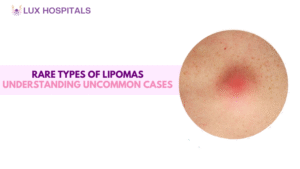Comprehensive Guide on Treatment for Acid Reflux & GERD

Acid reflux and Gastroesophageal Reflux Disease (GERD) are common conditions that affect the digestive system, causing discomfort and potential complications if left untreated. Acid reflux occurs when stomach acid flows back into the esophagus, leading to symptoms like heartburn and regurgitation. GERD is the more severe, chronic form of acid reflux that can lead to more serious health problems. In this blog, we will explore the most effective treatment options for Acid Reflux & GERD, providing a comprehensive guide for managing and alleviating symptoms.

Understanding Acid Reflux & GERD
Before diving into the treatment for Acid Reflux & GERD, it’s essential to understand the difference between the two. Acid reflux is a symptom of stomach acid moving into the esophagus, often causing a burning sensation in the chest known as heartburn. GERD, on the other hand, is a chronic condition where acid reflux occurs more frequently, potentially leading to damage to the esophageal lining, inflammation, and other complications.
Lifestyle Modifications
The first line of treatment for Acid Reflux & GERD typically involves lifestyle changes. These modifications can help reduce the frequency and severity of symptoms and are crucial in managing the condition long-term.
1. Dietary Adjustments
One of the most effective treatments for Acid Reflux & GERD is altering your diet. Avoiding foods and drinks that trigger symptoms is essential. Common triggers include fatty and fried foods, spicy dishes, chocolate, caffeine, alcohol, and acidic foods like tomatoes and citrus fruits. Eating smaller, more frequent meals rather than large meals can also help prevent acid from overwhelming the esophagus.
2. Weight management
Maintaining a healthy weight is crucial in the treatment for Acid Reflux & GERD. Excess weight, especially around the abdomen, puts pressure on the stomach, increasing the likelihood of acid reflux. Weight loss can significantly reduce this pressure, thereby decreasing the occurrence of acid reflux episodes.
3. Elevating the Head of the Bed
For those who experience nighttime symptoms, elevating the head of the bed can be an effective treatment for Acid Reflux & GERD. By raising the upper body, gravity helps prevent stomach acid from flowing back into the esophagus during sleep.
4. Avoiding Late-Night Meals
Eating at latenight or just before bed can exacerbate acid reflux symptoms. As part of the treatment for Acid Reflux & GERD, it’s recommended to avoid eating at least 2-3 hours before lying down to give the stomach time to empty and reduce the risk of acid reflux.
5. Quitting Smoking
Smoking can weaken the lower esophageal sphincter (LES), the muscle that prevents stomach acid from flowing back into the esophagus. Quitting smoking is a critical step in the treatment for Acid Reflux & GERD as it helps restore the function of the LES and reduces symptoms.
Medications for Acid Reflux & GERD
When lifestyle changes are not enough, medications become an essential part of the treatment for Acid Reflux & GERD. There are several types of medications that can help manage symptoms and prevent complications.
1.Antacids
Antacids are over-the-counter medications that provide quick relief by neutralizing stomach acid. They are often the first step in the treatment for Acid Reflux & GERD, particularly for mild symptoms. However, antacids only provide temporary relief and do not address the underlying cause of the condition.
2. H2 Blockers
H2 blockers, such as ranitidine and famotidine, work by reducing the amount of acid the stomach produces. These medications provide longer-lasting relief than antacids and are effective for mild to moderate symptoms of Acid Reflux & GERD. H2 blockers can be obtained both as over-the-counter medications and by prescription.
3. Proton Pump Inhibitors (PPIs)
Proton Pump Inhibitors (PPIs) are a class of medications that reduce the production of stomach acid more effectively than H2 blockers. PPIs, such as omeprazole and esomeprazole, are often used as a treatment for Acid Reflux & GERD, especially in cases where symptoms are severe or not adequately controlled by H2 blockers. PPIs not only alleviate symptoms but also promote healing of the esophageal lining if damage has occurred.
4. Prokinetics
Prokinetic agents are medications that help strengthen the LES and increase the rate at which the stomach empties, reducing the likelihood of acid reflux. While not as commonly prescribed as antacids, H2 blockers, or PPIs, prokinetics can be an effective treatment for Acid Reflux & GERD in certain cases, particularly where delayed gastric emptying is a contributing factor.
5. Alginates
Alginates are another treatment option for Acid Reflux & GERD. These medications form a protective barrier over the stomach contents, preventing acid from refluxing into the esophagus. Alginates can be particularly useful for those who experience symptoms after eating.
Surgical Treatment for Acid Reflux & GERD
When lifestyle changes and medications are insufficient, surgical options may be considered as a treatment for Acid Reflux & GERD. Surgery is generally reserved for those with severe symptoms that do not respond to other treatments or when there are complications like a hiatal hernia.
1.Fundoplication
Fundoplication is the most common surgical procedure used in the treatment for Acid Reflux & GERD. During this procedure, the surgeon wraps the top of the stomach around the lower esophagus to strengthen the LES, preventing acid reflux. Fundoplication can be performed using minimally invasive techniques, which reduces recovery time and postoperative discomfort.
2. LINX Device
The LINX device is a newer, less invasive treatment for Acid Reflux & GERD. It involves placing a small ring of magnetic beads around the LES. The magnetic attraction between the beads keeps the LES closed to prevent acid reflux but allows it to open when swallowing food. This procedure is reversible and offers a quicker recovery compared to traditional surgery.
3.Endoscopic Procedures
Several endoscopic procedures are also available as a treatment for Acid Reflux & GERD. These procedures involve using an endoscope (a thin, flexible tube with a camera) to tighten the LES or create a barrier to prevent acid reflux. Endoscopic treatments are minimally invasive and offer quicker recovery times, but they may not be suitable for everyone.
Long-Term Management and Prevention
Long-term management is key to successful treatment for Acid Reflux & GERD. In addition to continuing lifestyle modifications and medications, it’s important to monitor symptoms and work closely with a healthcare provider to adjust treatment as needed. Regular follow-ups can help prevent complications and ensure that the chosen treatment for Acid Reflux & GERD remains effective over time.
Conclusion
Effective treatment for Acid Reflux & GERD involves a combination of lifestyle changes, medications, and, in some cases, surgical interventions. By understanding the various treatment options available and working closely with a healthcare provider, individuals can manage their symptoms and improve their quality of life. If you experience persistent symptoms of Acid Reflux & GERD, it is important to seek medical advice to prevent complications and find the most appropriate treatment plan for your condition.
If your symptoms are severe or don’t improve, don’t wait—schedule an appointment at Lux Hospital for expert care and treatment. We focus on your comfort and well-being first.




















